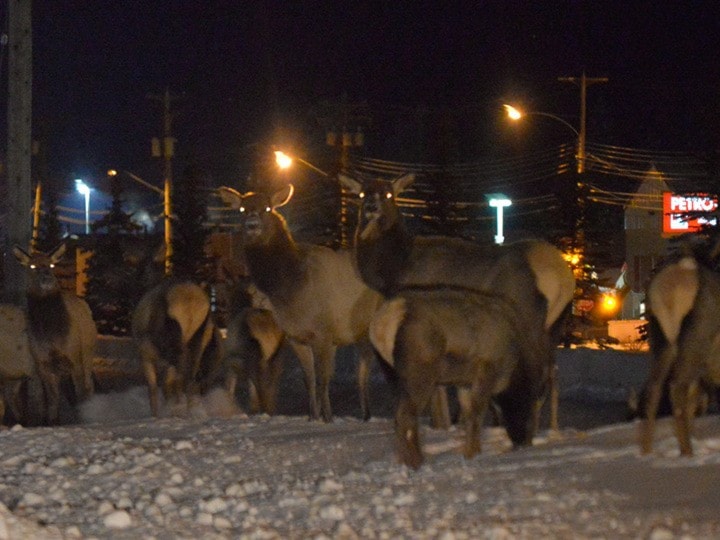By Phil McLachlan
An investigation by The Free Press indicates the most dangerous portion of Highway 3 from Cranbrook to the Alberta border for animal collisions is the stretch between Fernie and Sparwood.
Data compiled with the help from the Elk Valley RCMP, the Ministry of Transportation and Infrastructure and ICBC, indicates that this stretch of highway saw more wildlife collisions and resulting injuries than any other.
It saw a total of 41 collisions with wildlife from 2011 to 2015. In 2011, there were eight, in 2012 there were 14. There were seven in 2013, five in 2014 and seven in 2015. Five of these resulted in injury to the motorist. The 36 other cases resulted in property damage and injury to the animal.
Annual average daily traffic between Cranbrook and the Alberta border has remained constant, hovering at an average of 4448 vehicles per day.
Highway collision data from Cranbrook to the Alberta border was split into four segments. First, the Highway 3 stretch from Cranbrook to Elko saw a total of 19 wildlife collisions; nine in 2011, five in 2012, three in 2013, zero in 2014, and two in 2015. Out of the four sections of highway, this stretch is the safest in terms of motor-vehicle wildlife collisions.
Second, the stretch of Highway 3 between Elko and Fernie saw 33 total collisions in the five years time; eight in 2011, 11 in 2012, four in 2013, five in 2014 and five in 2015. Only nine of these resulted in an injury to the driver or passenger.
From Sparwood to the Alberta border, 23 collisions occurred; six in 2011, seven in 2012, one in 2013, four in 2014 and five in 2015. Five of these resulted in injury.
None of the sections between Cranbrook and the border saw a human fatality caused by a collision with wildlife. In total, 30 people were injured out of 116 incidents.
Thirty-seven motor-vehicle collisions with wildlife occured in 2012; the most of any year. Next was 2011 with a total of 31. In 2012, January saw the most incidents at a total number of six, with one collision resulting in an injury. Later on in the year, May was just one collision behind from January.
From 2011 to 2015, the month with the most total vehicle-wildlife incidents was August of 2011 with seven total collisions, all of which were damage-only with no injury.
The Sparwood RCMP regularly sees motor vehicle accidents occur throughout the Elk Valley, including a regular occurrence of incidents with animals from the area between Sparwood and the Alberta border.
Faced with situations involving an injured animal, the RCMP takes on the responsibility of dealing with it. Very rarely do they see an animal recover from a vehicle collision, but when they do it often involves bigger animals like bears, in which case a nearby conservation officer will be brought in to assess and monitor the animal from a distance.
The Ministry of Transportation sought out a solution for these collisions with wildlife, bringing about the introduction of wildlife detection systems. These help highway motorists avoid wildlife by warning them of nearby animals in the surrounding area.
“About one in 25 crashes are caused by wildlife collisions often leading to fatal injuries of these animals and causing serious injuries to those in the vehicle as well as contributing to increased injury and collision claims,” said Minister of Transportation and Infrastructure, Todd Stone.
In April of 2016, the Ministry released a statement, signifying the completion and launch of their new $1.5 million highway detection system.
The two sections of highway that saw the installation of this technology were one kilometre east of Elko, and approximately two kilometres east of Sparwood. These are areas which have been recognized as high-traffic areas, used by mining workers, commercial vehicles, locals as well as tourists.
“They’ve certainly slowed vehicles down, when there are animals being detected on the roadway,” said Elk Valley RCMP Constable, Robert Wright. “People going slower is going to lessen the likelihood or severity of a collision.”
The Ministry of Transportation staff have been piloting this project since late 2015 and will continue to monitor the data from these sites to see if there is a decrease in wildlife-related crashes. This data will be examined in following months, assessing the possibility of the implementation of this system into other parts of the province.
Constable Wright was previously posted in the area of Lake Louise, where he saw overhead animal crossings being implemented into highway zones. In areas like the Elk Valley, detection systems are being tested and just across the border in the Crowsnest Pass, overhead crossings are starting to become a reality.
“I think you’re going to see one of these two ideas take shape in the area,” said Wright. “They’re both working with varying degrees of success, but there’s still a few bugs to iron out before we get it right.”
